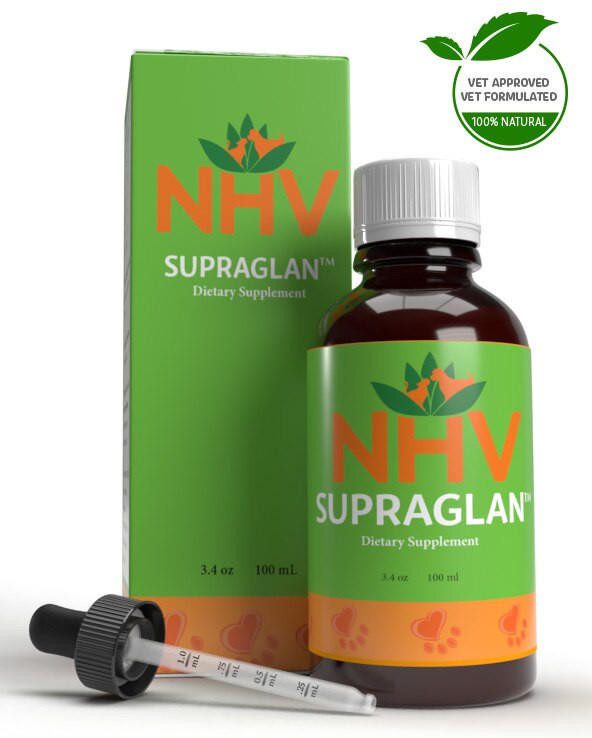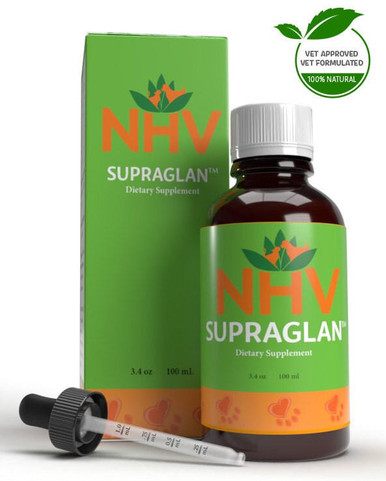cushing's support

free shipping over $100 (USA & Canada)
1-877-937-4372 the pet expert hotline


Have you ever heard of the adrenal gland? Or complicated condition names like hyperadrenocorticism and hypoadrenocorticism? If your answer is yes and you feel you don’t really understand what these words mean, then this article will help clarify common questions you may have, including the difference between Cushing’s and Addison’s disease.
The adrenal gland is a very important gland
The adrenal gland is a very important gland located close to the kidneys. Its main function is to produce hormones that are crucial to the body’s metabolism, like cortisol. When the cortisol level is higher or lower than normal, the metabolism and many vital functions are affected by this imbalance, manifesting different symptoms depending on the condition.
When the cortisol level is higher than normal, the condition is named hyperadrenocorticism, also known as Cushing’s disease. On the other hand, when the level is lower, the condition is named hypoadrenocorticism, mostly known as Addison’s disease. Even though these two conditions are related to the same gland, their symptoms are different and sometimes hard to diagnose.

Cushing’s disease (hyperadrenocorticism) is mostly caused by a tumor of the pituitary gland (central nervous system) that produces the hormone that stimulates the production of cortisol in the adrenal gland. Less common causes include tumors in the adrenal gland, and treatment-related causes, among others.
The symptoms caused by increased cortisol vary from case to case. The most common symptoms are:
Additionally, although not very common, most of the cats with Cushing’s disease have concurrent diabetes mellitus and may show severe thinning of the skin.
Regarding the available therapies for Cushing’s Disease, most cases are treated with long-term prescribed medication, which basically helps reduce cortisol production. In other cases, it might be necessary to recur to radiotherapy, especially if there are neurological signs. Sometimes, surgery can also be performed to treat cases when the results are potentially better than those with pharmaceuticals or radiotherapy.

Addison’s disease (hypoadrenocorticism) can be caused mostly by adrenal gland dysfunction that leads to reduced cortisol production. However, it can also be caused by prescribed pharmaceuticals and metastatic neoplasia, among others.
The symptoms of this condition are very vague, sometimes similar to those in Cushing’s disease, and usually exacerbated by stress. They can be confused with gastrointestinal issues and kidney disease, making it challenging for the diagnosis. The most reported symptoms include:
For pets in a stable health condition, the indicated therapy is lifelong hormone replacement through prescribed pharmaceuticals. The therapy must be closely monitored to determine if adjustments in the dosage are necessary in order to avoid side effects. Pets in critical condition, known as “Addisonian crisis” need emergency medical care as soon as possible.
Although opposite, these conditions can be easily mistaken due to the similarity of their symptoms, and this is why it’s important to identify the key differences between them.
To diagnose Cushing’s disease, blood tests may be performed
Cushing’s disease typically presents a set of symptoms that can make your vet suspect this condition. These include increased thirst, urination, and appetite, abdominal enlargement, hair loss, and changes in the skin. Even though these symptoms can raise suspicion of Cushing’s disease, the diagnosis can still be challenging for veterinarians. To diagnose Cushing’s disease, blood tests may be performed. They can measure the cortisol level in the blood following specific protocols that can reflect the adrenal and pituitary gland function. Blood tests can also help reflect the expected changes in parameters that can be affected by high cortisol levels. Additionally, since this condition can be caused by a tumor, sometimes imaging techniques may also support the diagnosis.
Addison’s disease is characterized by showing unspecific symptoms that can mimic other common conditions like renal disease or gastrointestinal issues, resulting in a risk of misdiagnosis. Because of this, and similarly to Cushing’s disease, it’s necessary to run specific blood tests to determine the adrenal gland’s condition. Additionally, given the lack of specificity of the symptoms, gathering further information on the pet’s health is crucial to veterinarians to rule out other possible diagnoses.
Treatment options for Cushing’s disease include long-term pharmaceutical therapy, radiotherapy, and surgical procedures. Sometimes, reducing cortisol production with pharmaceuticals is not effective enough and radiotherapy or surgery might be necessary.
Addison’s disease treatment consists of long-term hormonal replacement
On the other hand, Addison’s disease treatment consists of long-term hormonal replacement with pharmaceuticals with usually positive results.
Since both conditions are managed using prescribed pharmaceuticals intended to correct the level of cortisol, they require periodical monitoring to make sure the dosage is appropriate and prevent side effects.
We know how important your little one’s health is and that you want to keep them as healthy as possible. Since pet parents are who know better their fur babies, they’re the ones who can greatly contribute to their health and help detect any suspicious changes in their health.
If you recognize any changes in your little one’s health, like increased thirst and urination, changes in appetite, hair loss, and any other changes, seeking veterinary care is crucial. Early detection of health conditions is key to promoting your little one’s health as it allows your vet to establish a therapy on time and avoid other complications, especially for conditions that can be hard to diagnose, like Cushing’s and Addison’s disease.
cushing's support

Supraglan & Milk Thistle to Support Dog & Pet Cushing's Disease
bundle and save with pet expert kits
3 month supply for a small to medium size pet.
What is it?
This kit of NHV Supraglan and NHV Milk Thistle may support healthy adrenal gland function, liver enzyme levels, and help your pet to fight infections.
How Does it Work?
Why Should I Trust It?
Natural vet-formulated herbal supplements.


What is it?
This kit of NHV Supraglan and NHV Milk Thistle may support healthy adrenal gland function, liver enzyme levels, and help your pet to fight infections.
How Does it Work?
Why Should I Trust It?
Natural vet-formulated herbal supplements.

If your cat or dog has Cushing’s disease, the NHV Cushing’s Disease Essentials Kit may be beneficial in supporting your pet's overall health and well-being. The combination of NHV Supraglan and NHV Milk Thistle are vet approved and formulated to work synergistically in supporting their pituitary and adrenal gland, liver, and kidney function.
This kit can be taken alone, or together with the conventional Cushing’s treatment for cats and dogs that your veterinarian prescribes. These all-natural supplements are safe to take long-term.
Dog and cat Cushing’s disease is caused by the overproduction of the hormone cortisol by the adrenal gland. Animals with this disease have a suppressed immune system caused by the excessive production of cortisol in the body and are likely to get bladder infections due to this.
Supraglan is a natural herbal supplement that will help to balance the adrenal gland, improving the immune system and help the body fight infections. It may also aid in reducing thirst, excessive urination, appetite, help overall skin condition, and support the kidneys.
Milk Thistle helps support the liver and kidney function. Test results for animals that have Cushing’s indicated elevated liver enzyme levels and enlargement of the liver. Combing these products will help your pet live a healthy life. Visit our blog to read about other’s success in combating dog and pet Cushing’s disease with this essentials kit. Contact our pet experts if you have questions about options for Cushing’s treatment in cats & dogs.
Borage – Gently strengthens and improves adrenal function, and has been used for urinary issues and kidney inflammation.
Astragalus – Helps support the endocrine system, strengthens the immune system and acts as an anti-inflammatory. It has been found useful in helping the body recover from the effects of steroids, which affects the adrenal gland. Has both antibacterial and antiviral properties that aid your veterinarian’s recommended treatment for Cushing’s in cats & dogs.
Bistorte – A soothing anti-inflammatory that has a tonic effect on the liver and kidneys. In herbal medicine, it has been used to aid in urinary tract infections.
Eleuthero – A root that supports adrenal gland function, helps boost a sluggish metabolism, helps improve energy, and studies have shown that it improves the immune system.
Wild Yam – An herb that acts as a liver tonic, and helps normalize hormone production and kidney support. It helps with restlessness and nervousness.
Licorice – An herb that prevents the breakdown of the adrenal hormones. Improves digestion, helps boost immunity levels, and supports liver function.
Dandelion – A highly nutritious food that stimulates liver secretions, kidney function and improves digestion. High in natural vitamins and minerals.
Milk Thistle – In herbal medicine, this herb has been used for centuries to support, regenerate and remove toxins from the liver. Milk Thistle contains silymarin - a compound that protects the liver and stimulates, the production of new cells. It has powerful antioxidant properties, which helps strengthen the liver's resistance to toxic compounds. A healthy liver can be key to the treatment of Cushing’s disease in dogs and pets.
In pets, Milk Thistle is beneficial for damaged kidneys, as it has been shown to decrease the amount of time to heal while helping eliminate toxins.
Select your pet's weight to determine the correct dose.
To be taken twice daily. Determine your pet’s weight and then use the easy chart below to determine the correct dose. This is the minimum dosage.
Pet's Weight Dosage
0 - 15 lb = 0.5 ml
16 - 30 lb = 1.0 ml
31 - 45 lb = 1.5 ml
46 - 60 lb = 2.0 ml
61 - 75 lb = 2.5 ml
Over 75 lb = 3.0 ml
How to Administer
Refrigerate after opening.
Shake well. The easiest method is to use the dropper provided and place Supraglan and Milk Thistle drops into your dogs food or favorite treat. You can also use the dropper and squirt directly into the dogs mouth.
For Best Results
Herbal dietary supplements are beneficial to the health and well-being of your canine and are safe for long-term use. Every pet dog responds to natural herbal supplements differently, therefore it is important to be consistent and administer the product daily. Supplements generally take two to four weeks to take effect, however this will vary from one animal to the next.
Product Storage
All NHV Natural Pet Products are pure herbal extracts and contain no artificial additives, preservatives or coloring. Shelf life after opening is 6 months and must be refrigerated after opening.
Cautions and Contraindications
Do not use Supraglan in pregnant or nursing animals.
All information provided by NHV Natural Pet Products is for educational purposes only.
If your cat or dog has Cushing’s disease, the NHV Cushing’s Disease Essentials Kit may be beneficial in supporting your pet's overall health and well-being. The combination of NHV Supraglan and NHV Milk Thistle are vet approved and formulated to work synergistically in supporting their pituitary and adrenal gland, liver, and kidney function.
This kit can be taken alone, or together with the conventional Cushing’s treatment for cats and dogs that your veterinarian prescribes. These all-natural supplements are safe to take long-term.
Dog and cat Cushing’s disease is caused by the overproduction of the hormone cortisol by the adrenal gland. Animals with this disease have a suppressed immune system caused by the excessive production of cortisol in the body and are likely to get bladder infections due to this.
Supraglan is a natural herbal supplement that will help to balance the adrenal gland, improving the immune system and help the body fight infections. It may also aid in reducing thirst, excessive urination, appetite, help overall skin condition, and support the kidneys.
Milk Thistle helps support the liver and kidney function. Test results for animals that have Cushing’s indicated elevated liver enzyme levels and enlargement of the liver. Combing these products will help your pet live a healthy life. Visit our blog to read about other’s success in combating dog and pet Cushing’s disease with this essentials kit. Contact our pet experts if you have questions about options for Cushing’s treatment in cats & dogs.
Borage – Gently strengthens and improves adrenal function, and has been used for urinary issues and kidney inflammation.
Astragalus – Helps support the endocrine system, strengthens the immune system and acts as an anti-inflammatory. It has been found useful in helping the body recover from the effects of steroids, which affects the adrenal gland. Has both antibacterial and antiviral properties that aid your veterinarian’s recommended treatment for Cushing’s in cats & dogs.
Bistorte – A soothing anti-inflammatory that has a tonic effect on the liver and kidneys. In herbal medicine, it has been used to aid in urinary tract infections.
Eleuthero – A root that supports adrenal gland function, helps boost a sluggish metabolism, helps improve energy, and studies have shown that it improves the immune system.
Wild Yam – An herb that acts as a liver tonic, and helps normalize hormone production and kidney support. It helps with restlessness and nervousness.
Licorice – An herb that prevents the breakdown of the adrenal hormones. Improves digestion, helps boost immunity levels, and supports liver function.
Dandelion – A highly nutritious food that stimulates liver secretions, kidney function and improves digestion. High in natural vitamins and minerals.
Milk Thistle – In herbal medicine, this herb has been used for centuries to support, regenerate and remove toxins from the liver. Milk Thistle contains silymarin - a compound that protects the liver and stimulates, the production of new cells. It has powerful antioxidant properties, which helps strengthen the liver's resistance to toxic compounds. A healthy liver can be key to the treatment of Cushing’s disease in dogs and pets.
In pets, Milk Thistle is beneficial for damaged kidneys, as it has been shown to decrease the amount of time to heal while helping eliminate toxins.
Select your pet's weight to determine the correct dose.
To be taken twice daily. Determine your pet’s weight and then use the easy chart below to determine the correct dose. This is the minimum dosage.
Pet's Weight Dosage
0 - 15 lb = 0.5 ml
16 - 30 lb = 1.0 ml
31 - 45 lb = 1.5 ml
46 - 60 lb = 2.0 ml
61 - 75 lb = 2.5 ml
Over 75 lb = 3.0 ml
How to Administer
Refrigerate after opening.
Shake well. The easiest method is to use the dropper provided and place Supraglan and Milk Thistle drops into your dogs food or favorite treat. You can also use the dropper and squirt directly into the dogs mouth.
For Best Results
Herbal dietary supplements are beneficial to the health and well-being of your canine and are safe for long-term use. Every pet dog responds to natural herbal supplements differently, therefore it is important to be consistent and administer the product daily. Supplements generally take two to four weeks to take effect, however this will vary from one animal to the next.
Product Storage
All NHV Natural Pet Products are pure herbal extracts and contain no artificial additives, preservatives or coloring. Shelf life after opening is 6 months and must be refrigerated after opening.
Cautions and Contraindications
Do not use Supraglan in pregnant or nursing animals.
All information provided by NHV Natural Pet Products is for educational purposes only.
adrenal support

Supraglan, Milk Thistle & Multi Essentials
bundle and save with pet expert kits
3 month supply for a small to medium size pet.
What is it?
Our pet adrenal support is formulated to support and balance the adrenal glands, aid effective detoxification, and deliver vital nutrients to support metabolism and other important body processes.
How Does it Work?
Why Should I Trust It?
Supplements formulated by a holistic veterinarian and master herbalist.


What is it?
Our pet adrenal support is formulated to support and balance the adrenal glands, aid effective detoxification, and deliver vital nutrients to support metabolism and other important body processes.
How Does it Work?
Why Should I Trust It?
Supplements formulated by a holistic veterinarian and master herbalist.

Symptoms of overactive or underactive adrenal glands can often be mistaken for normal signs of aging. If your furkiddo is looking a little dull, doesn’t want to play or their appetite is all over the place, they may be suffering from an adrenal imbalance and malnutrition.
They are two small glands located next to the kidneys that work alongside the pituitary and hypothalamus glands to help regulate digestion, the immune system, and most importantly, the body’s response to stress.
When your furkiddo is stressed, their adrenal glands produce the hormones that stimulate a fight or flight response. This primal reaction can be a real lifesaver in many dangerous situations, but problems may develop when your dog or cat's adrenal system releases too much or too little of these glucocorticoid hormones. Stress can be triggered by many factors such as surgery, trauma, a change in routine, illness or even extreme weather.
Two of the most common adrenal gland disorders are Cushing’s disease (too much cortisol in the bloodstream) and Addison’s disease (too little cortisol and aldosterone).
Cushing's Disease or hyperadrenocorticism is caused by the overproduction of the hormone ACTH which is then released into the bloodstream and stimulates the adrenal glands to produce increased levels of cortisol. The adrenal glands can be pushed into overdrive from a few different causes, but most commonly, Cushing’s is caused by a tumor on the pituitary gland, known as an adenoma. As scary as this sounds, it may not be life-threatening, and if caught early, your pet may be able to maintain a good quality of life and minimize symptoms. If left untreated, this type of tumor may become metastatic and develop into cancer. The telltale signs of Cushing's disease often resemble normal aging due to symptoms like lethargy, weight gain, and a dull and dry coat. Also, age is most likely a factor as Cushing's does not usually develop in dogs until the age of ten. Although less common, Cushing’s (too much cortisol) can affect our feline friends too.
Certain breeds of dogs are more prone to Cushing’s, partly because certain breeds are more prone to stress. Poodles, Jack Russell Terriers, Beagles, and Dachshunds are a few dog breeds that are more likely to develop this kind of glandular disorder.
Addison’s Disease or hypoadrenocorticism occurs when the adrenal glands fail to produce enough hormones. Standard Poodles, Great Danes, Bearded Collies, Portuguese Water Dogs and West Highland White Terriers are some of the breeds that may be more susceptible to this glandular disorder. Addison’s Disease (too little hormone) is more common in young to middle-aged dogs and in some purebred cats.
There are two types of Addison’s Disease, primary and secondary. The primary type of Addison’s is essentially a rare autoimmune disorder where the immune system attacks the adrenal glands and damages the adrenal cortex. If your furry friend is battling tumors, other diseases or is taking vet-prescribed medications to treat Cushing's, these may be contributing factors to an underactive adrenal cortex, which leads to secondary Addison’s Disease caused by a pituitary gland tumor, long-term exposure to steroids or a side effect of suddenly pausing a medication.
The symptoms of adrenal disorders can be similar to various other health conditions in pets so your vet may recommend some in-depth diagnostic tests like a CBC, a chemistry panel, electrolyte tests and ACTH-stimulation tests to investigate your furkiddo’s symptoms.
For adrenal disease in cats or dogs with possible malnutrition (from diarrhea and excessive urination), we'd suggest adding NHV’s Adrenal Super Support and Nutritional Balance Kit to their daily meals. This bundle of natural remedies contains Supraglan, Milk thistle and Multi Essentials which have been specifically formulated for pets to gently re-balance the adrenal glands, reduce inflammation, and eliminate toxins.
An adrenal gland disorder impacts so many areas of the body. We would recommend a holistic pet adrenal support that connects and aids each of the affected areas while minimizing side effects to help your little one get their health back on track. Suplaglan is an all-natural blend of herbs specially formulated to focus on all areas affected by glandular disorders like Cushing’s or Addison's Disease. Wild yam helps restore hormone balance, licorice encourages hormone production, and borage naturally stimulates the endocrine system to rebalance adrenal cortex function and support a calmer body and mind. In addition to helping the adrenal and endocrine system, Suplaglan also contains herbs that support the kidneys, liver, and immune system, which we know are vital to maintaining a healthy body. Milk Thistle provides additional support to the liver, kidneys, and is known to encourage cell regeneration. And Multi Essentials help replenish vital nutrients that your pet may have lost from increased urination, diarrhea and a fluctuating metabolism (from unstable hormone levels).
Your pet’s health means everything to us. For our pet adrenal support kits, we have worked with a holistic veterinarian and a master herbalist to formulate gentle yet effective remedies to focus on the areas of the body most affected by Cushing’s and Addison’s disease. For any questions or concerns about your little one’s stress levels or adrenal health, don’t hesitate to reach out to an NHV Pet Expert - we are here to help!
Made with the finest, organically grown, or ethically harvested herbs. Made specifically for pets, vet-formulated and vet approved.
Supraglan
Milk Thistle
Multi Essentials
Select your pet's weight to determine the correct dose.
To be taken twice daily. Determine your pet’s weight and then use the easy chart below to determine the correct dose. This is the minimum dosage.
Pet's Weight Dosage
0 - 15 lb = 0.5 ml
16 - 30 lb = 1.0 ml
31 - 45 lb = 1.5 ml
46 - 60 lb = 2.0 ml
61 - 75 lb = 2.5 ml
Over 75 lb = 3.0 ml
For small animals (rabbits, ferrets), avians and reptiles use 1 drop for every 2 lb of body weight.
How to Administer
Shake well before use. The easiest method is to use the dropper provided and place the drops into your pet’s food or favorite treat. You can also use the dropper and squirt directly into the pet’s mouth. Some pets can be finicky, if this occurs consider hiding the drops in foods most pet’s love such as fish, chicken or yogurt or a favorite treat. If your pet only eats dry food then soak a few kibbles at feeding time.
For Best Results
Herbal dietary supplements are beneficial to the health and well-being of your pet and are safe for long-term use. Every pet responds to natural herbal supplements differently, therefore it is important to be consistent and administer the product daily. Supplements generally take two to four weeks to take effect, however this will vary from one animal to the next.
Product Storage
All NHV Natural Pet Products are pure herbal extracts and contain no artificial additives, preservatives or coloring. Shelf life after opening is 6 months and must be refrigerated after opening.
Cautions and Contraindications
Do not use Supraglan in pregnant or nursing animals. Speak to your vet before using our products. A second visit is recommended if your pet’s condition does not improve, or deteriorates after continued use of the supplements.
All information provided by NHV Natural Pet Products is for educational purposes only.
Symptoms of overactive or underactive adrenal glands can often be mistaken for normal signs of aging. If your furkiddo is looking a little dull, doesn’t want to play or their appetite is all over the place, they may be suffering from an adrenal imbalance and malnutrition.
They are two small glands located next to the kidneys that work alongside the pituitary and hypothalamus glands to help regulate digestion, the immune system, and most importantly, the body’s response to stress.
When your furkiddo is stressed, their adrenal glands produce the hormones that stimulate a fight or flight response. This primal reaction can be a real lifesaver in many dangerous situations, but problems may develop when your dog or cat's adrenal system releases too much or too little of these glucocorticoid hormones. Stress can be triggered by many factors such as surgery, trauma, a change in routine, illness or even extreme weather.
Two of the most common adrenal gland disorders are Cushing’s disease (too much cortisol in the bloodstream) and Addison’s disease (too little cortisol and aldosterone).
Cushing's Disease or hyperadrenocorticism is caused by the overproduction of the hormone ACTH which is then released into the bloodstream and stimulates the adrenal glands to produce increased levels of cortisol. The adrenal glands can be pushed into overdrive from a few different causes, but most commonly, Cushing’s is caused by a tumor on the pituitary gland, known as an adenoma. As scary as this sounds, it may not be life-threatening, and if caught early, your pet may be able to maintain a good quality of life and minimize symptoms. If left untreated, this type of tumor may become metastatic and develop into cancer. The telltale signs of Cushing's disease often resemble normal aging due to symptoms like lethargy, weight gain, and a dull and dry coat. Also, age is most likely a factor as Cushing's does not usually develop in dogs until the age of ten. Although less common, Cushing’s (too much cortisol) can affect our feline friends too.
Certain breeds of dogs are more prone to Cushing’s, partly because certain breeds are more prone to stress. Poodles, Jack Russell Terriers, Beagles, and Dachshunds are a few dog breeds that are more likely to develop this kind of glandular disorder.
Addison’s Disease or hypoadrenocorticism occurs when the adrenal glands fail to produce enough hormones. Standard Poodles, Great Danes, Bearded Collies, Portuguese Water Dogs and West Highland White Terriers are some of the breeds that may be more susceptible to this glandular disorder. Addison’s Disease (too little hormone) is more common in young to middle-aged dogs and in some purebred cats.
There are two types of Addison’s Disease, primary and secondary. The primary type of Addison’s is essentially a rare autoimmune disorder where the immune system attacks the adrenal glands and damages the adrenal cortex. If your furry friend is battling tumors, other diseases or is taking vet-prescribed medications to treat Cushing's, these may be contributing factors to an underactive adrenal cortex, which leads to secondary Addison’s Disease caused by a pituitary gland tumor, long-term exposure to steroids or a side effect of suddenly pausing a medication.
The symptoms of adrenal disorders can be similar to various other health conditions in pets so your vet may recommend some in-depth diagnostic tests like a CBC, a chemistry panel, electrolyte tests and ACTH-stimulation tests to investigate your furkiddo’s symptoms.
For adrenal disease in cats or dogs with possible malnutrition (from diarrhea and excessive urination), we'd suggest adding NHV’s Adrenal Super Support and Nutritional Balance Kit to their daily meals. This bundle of natural remedies contains Supraglan, Milk thistle and Multi Essentials which have been specifically formulated for pets to gently re-balance the adrenal glands, reduce inflammation, and eliminate toxins.
An adrenal gland disorder impacts so many areas of the body. We would recommend a holistic pet adrenal support that connects and aids each of the affected areas while minimizing side effects to help your little one get their health back on track. Suplaglan is an all-natural blend of herbs specially formulated to focus on all areas affected by glandular disorders like Cushing’s or Addison's Disease. Wild yam helps restore hormone balance, licorice encourages hormone production, and borage naturally stimulates the endocrine system to rebalance adrenal cortex function and support a calmer body and mind. In addition to helping the adrenal and endocrine system, Suplaglan also contains herbs that support the kidneys, liver, and immune system, which we know are vital to maintaining a healthy body. Milk Thistle provides additional support to the liver, kidneys, and is known to encourage cell regeneration. And Multi Essentials help replenish vital nutrients that your pet may have lost from increased urination, diarrhea and a fluctuating metabolism (from unstable hormone levels).
Your pet’s health means everything to us. For our pet adrenal support kits, we have worked with a holistic veterinarian and a master herbalist to formulate gentle yet effective remedies to focus on the areas of the body most affected by Cushing’s and Addison’s disease. For any questions or concerns about your little one’s stress levels or adrenal health, don’t hesitate to reach out to an NHV Pet Expert - we are here to help!
Made with the finest, organically grown, or ethically harvested herbs. Made specifically for pets, vet-formulated and vet approved.
Supraglan
Milk Thistle
Multi Essentials
Select your pet's weight to determine the correct dose.
To be taken twice daily. Determine your pet’s weight and then use the easy chart below to determine the correct dose. This is the minimum dosage.
Pet's Weight Dosage
0 - 15 lb = 0.5 ml
16 - 30 lb = 1.0 ml
31 - 45 lb = 1.5 ml
46 - 60 lb = 2.0 ml
61 - 75 lb = 2.5 ml
Over 75 lb = 3.0 ml
For small animals (rabbits, ferrets), avians and reptiles use 1 drop for every 2 lb of body weight.
How to Administer
Shake well before use. The easiest method is to use the dropper provided and place the drops into your pet’s food or favorite treat. You can also use the dropper and squirt directly into the pet’s mouth. Some pets can be finicky, if this occurs consider hiding the drops in foods most pet’s love such as fish, chicken or yogurt or a favorite treat. If your pet only eats dry food then soak a few kibbles at feeding time.
For Best Results
Herbal dietary supplements are beneficial to the health and well-being of your pet and are safe for long-term use. Every pet responds to natural herbal supplements differently, therefore it is important to be consistent and administer the product daily. Supplements generally take two to four weeks to take effect, however this will vary from one animal to the next.
Product Storage
All NHV Natural Pet Products are pure herbal extracts and contain no artificial additives, preservatives or coloring. Shelf life after opening is 6 months and must be refrigerated after opening.
Cautions and Contraindications
Do not use Supraglan in pregnant or nursing animals. Speak to your vet before using our products. A second visit is recommended if your pet’s condition does not improve, or deteriorates after continued use of the supplements.
All information provided by NHV Natural Pet Products is for educational purposes only.
adrenal support

Natural Cushing’s Disease, Adrenal, and Addison’s Support for dogs
buy 2 and save $3
3 month supply for a small to medium size
What is it?
Our vet-formulated canine adrenal and Cushing’s support product can help your dog get the nutrients they need to balance vital hormones and promote healthy adrenal gland function.
How does it work?
Why trust it?
NHV Supraglan is safe to use alongside your veterinarian's recommendations.


What is it?
Our vet-formulated canine adrenal and Cushing’s support product can help your dog get the nutrients they need to balance vital hormones and promote healthy adrenal gland function.
How does it work?
Why trust it?
NHV Supraglan is safe to use alongside your veterinarian's recommendations.

Dogs with adrenal disorders like Cushing’s and Addison’s may have other health issues that can affect a pup’s quality of life. Supraglan™ canine adrenal support supplements can help these dogs.
The overproduction of cortisol in canines with Cushing’s disease can cause excessive thirst, urination, and appetite. These symptoms can result in other side effects like obesity, fat pads near the neck, and low energy.
Cushing’s disease may sometimes be the result of continued steroid use or a tumor on the adrenal gland. Your vet’s treatment plan for Cushing’s or other canine adrenal support will likely include medication and potential surgery in cases where a tumor is present. Feeding Supraglan™ supplements to your dog alongside the vet’s treatment will help them through the process.
Our adrenal supplements can help dogs undergoing treatment for diseases like Cushing’s with powerful and natural ingredients that help improve adrenal gland function, regulate metabolism, and promote good digestion.
Supraglan™ is formulated with ingredients like borage which help to balance a dog’s endocrine system, astragalus for its anti-inflammatory effects, eleuthero to help regulate adrenal gland function, and other potent ingredients key in supporting their overall health.
For additional support, see NHV’s other adrenal disorder supplements and kits.
All of NHV’s canine adrenal support products are ethically sourced, free of GMOs, and tested by a third party to ensure concentration and product quality. Find natural solutions you can trust in your dog’s health regimen when you shop at NHV.
Borage – Helps to balance endocrine system functions, restore the adrenal cortex, and eliminate toxins
Astragalus – Contains anti-inflammatory properties and balance your dog’s immunity
Bistort – Contains anti-inflammatory properties that benefit the liver and kidneys
Eleuthero – Helps balance (Acts on, supports, aids, assists) adrenal gland function and may help balance metabolism
Wild Yam – Helps balance and normalizes liver function
Licorice – Contains anti-inflammatory properties and balance adrenal gland function
Dandelion – Helps balance liver secretions and promotes good digestion
Select your pet's weight to determine the correct dose.
To be taken twice daily. Determine your pet’s weight and then use the easy chart below to determine the correct dose. This is the minimum dosage.
Pet's Weight Dosage
0 - 15 lb = 0.5 ml
16 - 30 lb = 1.0 ml
31 - 45 lb = 1.5 ml
46 - 60 lb = 2.0 ml
61 - 75 lb = 2.5 ml
Over 75 lb = 3.0 ml
For small animals (rabbits, ferrets), avians and reptiles use 1 drop for every 2 lb of body weight.
How to Administer
Shake well before use. The easiest method is to use the dropper provided and place the drops into your pet’s food or favorite treat. You can also use the dropper and squirt directly into the pet’s mouth. Some pets can be finicky, if this occurs consider hiding the drops in foods most pet’s love such as fish, chicken or yogurt or a favorite treat. If your pet only eats dry food then soak a few kibbles at feeding time.
For Best Results
Herbal dietary supplements are beneficial to the health and well-being of your pet and are safe for long-term use. Every pet responds to natural herbal supplements differently, therefore it is important to be consistent and administer the product daily. Supplements generally take two to four weeks to take effect, however this will vary from one animal to the next.
Product Storage
All NHV Natural Pet Products are pure herbal extracts and contain no artificial additives, preservatives or coloring. Shelf life after opening is 6 months and must be refrigerated after opening.
Cautions and Contraindications
Do not use Supraglan in pregnant or nursing animals. Speak to your vet before using our products. A second visit is recommended if your pet’s condition does not improve, or deteriorates after continued use of the supplements.
All information provided by NHV Natural Pet Products is for educational purposes only.
Dogs with adrenal disorders like Cushing’s and Addison’s may have other health issues that can affect a pup’s quality of life. Supraglan™ canine adrenal support supplements can help these dogs.
The overproduction of cortisol in canines with Cushing’s disease can cause excessive thirst, urination, and appetite. These symptoms can result in other side effects like obesity, fat pads near the neck, and low energy.
Cushing’s disease may sometimes be the result of continued steroid use or a tumor on the adrenal gland. Your vet’s treatment plan for Cushing’s or other canine adrenal support will likely include medication and potential surgery in cases where a tumor is present. Feeding Supraglan™ supplements to your dog alongside the vet’s treatment will help them through the process.
Our adrenal supplements can help dogs undergoing treatment for diseases like Cushing’s with powerful and natural ingredients that help improve adrenal gland function, regulate metabolism, and promote good digestion.
Supraglan™ is formulated with ingredients like borage which help to balance a dog’s endocrine system, astragalus for its anti-inflammatory effects, eleuthero to help regulate adrenal gland function, and other potent ingredients key in supporting their overall health.
For additional support, see NHV’s other adrenal disorder supplements and kits.
All of NHV’s canine adrenal support products are ethically sourced, free of GMOs, and tested by a third party to ensure concentration and product quality. Find natural solutions you can trust in your dog’s health regimen when you shop at NHV.
Borage – Helps to balance endocrine system functions, restore the adrenal cortex, and eliminate toxins
Astragalus – Contains anti-inflammatory properties and balance your dog’s immunity
Bistort – Contains anti-inflammatory properties that benefit the liver and kidneys
Eleuthero – Helps balance (Acts on, supports, aids, assists) adrenal gland function and may help balance metabolism
Wild Yam – Helps balance and normalizes liver function
Licorice – Contains anti-inflammatory properties and balance adrenal gland function
Dandelion – Helps balance liver secretions and promotes good digestion
Select your pet's weight to determine the correct dose.
To be taken twice daily. Determine your pet’s weight and then use the easy chart below to determine the correct dose. This is the minimum dosage.
Pet's Weight Dosage
0 - 15 lb = 0.5 ml
16 - 30 lb = 1.0 ml
31 - 45 lb = 1.5 ml
46 - 60 lb = 2.0 ml
61 - 75 lb = 2.5 ml
Over 75 lb = 3.0 ml
For small animals (rabbits, ferrets), avians and reptiles use 1 drop for every 2 lb of body weight.
How to Administer
Shake well before use. The easiest method is to use the dropper provided and place the drops into your pet’s food or favorite treat. You can also use the dropper and squirt directly into the pet’s mouth. Some pets can be finicky, if this occurs consider hiding the drops in foods most pet’s love such as fish, chicken or yogurt or a favorite treat. If your pet only eats dry food then soak a few kibbles at feeding time.
For Best Results
Herbal dietary supplements are beneficial to the health and well-being of your pet and are safe for long-term use. Every pet responds to natural herbal supplements differently, therefore it is important to be consistent and administer the product daily. Supplements generally take two to four weeks to take effect, however this will vary from one animal to the next.
Product Storage
All NHV Natural Pet Products are pure herbal extracts and contain no artificial additives, preservatives or coloring. Shelf life after opening is 6 months and must be refrigerated after opening.
Cautions and Contraindications
Do not use Supraglan in pregnant or nursing animals. Speak to your vet before using our products. A second visit is recommended if your pet’s condition does not improve, or deteriorates after continued use of the supplements.
All information provided by NHV Natural Pet Products is for educational purposes only.
Published: April 15, 2025